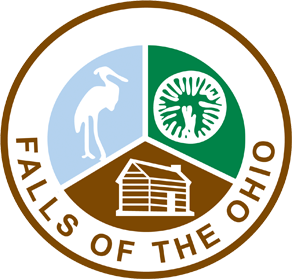Discover the wonder of the Falls of the Ohio with our naturalist-led programs for students of all ages. Outreach will be offered with labs at your school (primarily in Clark and Floyd Co., Indiana and Jefferson Co., Kentucky) or summer camp. Beyond that distance, educators please call us at 812-280-9970 to determine if we can come to your school. Our limit is about a 45 minute radius from the Falls of the Ohio. Check out our loaner kits through our Museum to Go program.
Hands-On Fossil and Mineral Labs
Lab length: 45 minutes
Maximum number per lab: 30 students
Maximum number per school: 1 class per period
Fossil Discovery Lab
for 3rd grade & above
Indiana Science Standards Met
3.2.4, 3.2.5, 4.2.2, 4.2.4, 4.3.2, 4.3.3, 7.2.8
Kentucky Science Standards Met
3-LS2-1, 3-LS4-1, 3-LS4-4, LS4.A and .C, 4-ESS1-1, 4-ESS1.C,
06-LS2-2, 06-LS2.A and C, 08-LS4-1, 08-LS4-2, LS4.A
Brief Description:
Students are introduced to fossils, how to identify them and how they are interpreted as living creatures.
Objectives:
Students will…
1.) know what a fossil is.
2.) recognize similarities and differences in modern marine life.
3.) be able to recognize differences between carnivores, herbivores, scavengers and filter feeders.
4.) be able to identify eight fossils from 20 illustrations.
5.) know how shale is formed.
6.) be able to differentiate fossils from ordinary shale.
7.) be able to match fossils with the their feeding style: carnivores, herbivores, scavengers and filter feeders.
8.) be able to identify pyrite (fool’s gold) as a mineral.
The lab begins with an introduction “What is a fossil?” Since understanding life today helps us understand how life used to be, students will identify 10 – 20 different types of organisms in the ocean. A review of their feeding styles will be made.
The first hands-on activity involves matching fossils from the Falls of the Ohio with an identification sheet. Students will handle their fossil using the shape and pattern to identify it with the ID sheets. They will learn how it is possible to reconstruct life-styles of fossils based on their modern counterparts.
Working in teams, students will sort through a Middle Silurian shale (about 421 million years old) to discover what fossils may be found. A guide will be used to identify the fossils, which may include: brachiopods, bryozoans, cephalopods, clams, corals, crinoids, cystoids, graptolites, snails, sponges, trilobites and trace fossils. We will review those fossil types not discussed earlier. Schools will be given information to participate in a school initiative called the Waldron Shale Project, a program being developed by Bellarmine University and the Falls of the Ohio State Park that provides real-world investigative activities in the classroom to boost science literacy and contribute to a research project.


K – 2nd grade
Indiana Standards: K.3.1, K.3.2, 1.3.1, 1.3.2, 1.3.3, 1.3.4
Kentucky Standards: K-LS1-1, K-ESS3-1, 2-LS4-1
Brief Description:
Students are introduced to fossils, how to identify them and how they the Devonian sea compares to today.
Goal: Students will learn how life is similar, and yet changed from life during the Devonian period.
Objectives: Students will…
1.) know what a fossil is.
2.) recognize similarities and differences between Devonian and modern marine life.
3.) be able to recognize differences between different forms of life.
4.) be able to identify eight fossils from 20 illustrations.
5.) Students will understand that creatures live in different parts of the sea and are adapted to live there.
The lab begins with an introduction “What is a fossil?” We cobble together a definition based on the input from students.
The first hands-on activity allows the students to handle and try to match their fossil with picture identification pages.
The second part of the lab in an activity where students draw a Devonian ocean scene. First students are asked to name different creatures that live in the ocean. If one existed during the Devonian, it is drawn on the board. If it did not exist, it is not used. If an ancestor to something around today existed during the Devonian, then the drawing is of the ancient creature, not is modern descendant. Students draw and color a scene based on the illustrations on the white board; they are encouraged to be as creative as possible. Students keep their art work. (See photos below.)


Minerals and Our World Lab
for 3rd grade & above
Indiana Standards: ES 3.2.2, 3.2.3, 3.2.6, 4.2.4, 8.2.7
Kentucky Standards:2-PS1-1, 2-PS1-2
Brief Description:
This lab focuses on observing the characteristics of minerals (how they are different from rocks) and the application of ores (rocks and minerals) used in our lives. It will help students make the connections to real-world applications of minerals.
Goal: Students will understand some fundamental differences between rocks and minerals and learn how minerals are an essential part of their day-to-day lives.
Objectives: Students will…
1.) know what a rock is.
2.) know what a mineral is.
3.) be able to recognize the characteristics of luster, color and crystal form in minerals.
4.) be able to identify uses for copper, calcium, fluorine, iron, lead and silica.
5.) pick out every day items made of minerals in a room.
6.) recognize objects used by prehistoric people made from rocks or minerals.
The lab begins with students examining a piece of limestone and calcite and determining which is a rock and mineral through simple observation.
Students get one of six minerals to examine and learn some of the properties (luster, crystal form, color) and write a description.
Students will write the dominant element of their mineral and how it might be used in things see in their daily lives.
The instructor will ask students to point out any item in the room and learn which minerals are used to make it (i.e., drywall – gypsum; brick – clay minerals; window – quartz, etc.).
Prehistoric projectile points are handled and drawn. The use of rocks and minerals used thousands of years ago will be discussed. Why was salt so valuable? What makes a gemstone valuable?
